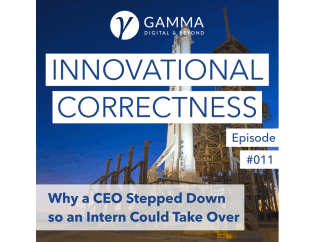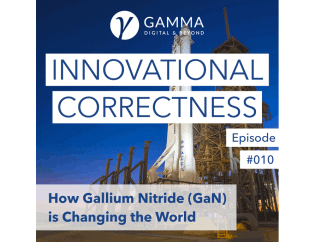This innovation & transformation podcast looks at innovators and companies that are changing the game and how they took their initial idea and created a game-changing product or service while giving you unique perspectives and insights you haven’t heard elsewhere. David and his guests discuss real-world practical advice on how to best harness the creativity of your employees and go from idea to product that has the potential to radically transform your business, all while separating hype from reality and replacing bullshit bingo with common sense.
Hosted on Acast. See acast.com/privacy for more information.
In today‘s episode, I talk to Dr. Joachim Kuhn who is the CEO and founder of va-Q-tec – a very innovative company that produces highly efficient and space-saving vacuum panels that insulate 10 times better than traditional insulators and will remain the best insulation material for the century.
va-Q-tec has won the TOP 100 innovator award, has been the National Champion at the “European Business Awards” multiple times, and made it into the TOP 10 of the GreenTec awards, along with so many other awards and recognitions that it would seriously take a half an hour to name them all.
In this episode I talk to Dr. Joachim Kuhn and explore:
- What vacuum insulated panels are and what they can be used for,
- What makes them so special, along with some of their properties,
- Why a vacuum is such a good insulator that it will be the best insulator for the next 100-150 years,
- How do common insulators such as styrofoam perform against vacuum panels (spoiler alert: it‘s staggering)?
- Some of the challenges he faces with his innovative vacuum panels,
- How his product stakes up against the competition and how he‘s able to compete against Asian manufacturers, despite there being much cheaper,
- The steps his company is currently taking to make these panels much more affordable and available for more customer applications,
- How he decides which market to enter next, when the potential of his product is so vast,
- Why he didn‘t take his successful company to Silicon Valley, but instead stayed in Germany,
- What he recommends companies do to bring their breakthrough innovation to market,
- and so much more.
Show Notes, Transcription, & Resources Mentioned: gammabeyond.com/en/podcast/013
Podcast Website: www.innovationalcorrectness.com
—
If you enjoyed this episode, could I ask you for one small favor?
Would you please consider rating and reviewing this podcast on iTunes, Overcast or the podcast app of your choice? It really helps us out, by encouraging more people to find our podcast and reach hard-to-get guests.
Last but not least, if you have any suggestions for further episodes or guests should be invited on this podcast or just have feedback, shoot us a quick email: or fill out our feedback form.
Follow & add David on:
LinkedIn:linkedin.com/in/davidluna/
Youtube: youtube.com/c/GAMMADigitalBeyond
Hosted on Acast. See acast.com/privacy for more information.

Show Notes
Episode Contents
In this episode I talk to Dr. Joachim Kuhn and explore
- What vacuum insulated panels are and what they can be used for,
- What makes them so specials, along with some of their properties,
- Why a vacuum is such a good insulator that it will be the best insulator for the next 100-150 years,
- How common insulators such as styrofoam perform against vacuum panels (spoiler alert: it's staggering)?
- Some of the challenges he faces with his innovative vacuum panels,
- How his product stakes up against the competition and how he's able to compete against Asian manufacturer, despite these being much cheaper,
- The steps his company is currently taking to make these panels much more affordable and available for more customer applications,
- How he decides which market to enter next, when the potential of his product is so vast,
- Why he didn't take his successful company to Silicon Valley, but instead stayed in Germany,
- What he recommends companies do to bring their breakthrough innovation to market,
- and so much more.
Links & Resources Mentioned
Links Mentioned
Books Mentioned
(*) These links contain affiliate/advertising links. If you click on one of these affiliate links and make a purchase, I will receive a commission from the corresponding online store. Our impartial podcasts are funded in part by affiliate commissions, at no extra cost to our readers. Your support really helps us out, creating even better episodes! ?
- The Paradox of Choice - Why More Is Less by Barry Schwartz*
Videos Mentioned
Companies Mentioned
People Mentioned
David C. Luna: LinkedIn
Note: This transcript of the episode was machine-generated and has not been edited for correctness. It's provided for your convenience when searching. Please excuse any errors.
[00:00:00] Host (David C. Luna): While we're on the subject of space. Have you talked to Elon yet about your high performance vacuum panels for his space X project?
[00:00:07] Guest (Dr. Joachim Kuhn): Not yet, but I'm going to drink a beer with him.
[00:00:14] Host (David C. Luna): Welcome to innovation, no correctness, a podcast, all about innovation and transformation hosted by David Luna, author keynote speaker and founder of gamma digital and beyond David and his guests discuss real world practical advice. On how to best harness the creativity of your employees and go from idea to product, giving you unique perspectives and insights into their success all while separating, hype from reality and replacing bullshit.
[00:00:41] Bingo. With common sense, let's jump right into the show. We're back at it again with another episode of the innovation or correctness podcast. And today's episode, I talked to dr. Johan Kuhn, who is the CEO and founder of vacuum tech, a very innovative company that produces highly
[00:01:00] efficient space saving and environmentally friendly vacuum insulation panels.
[00:01:04] That insulate 10 times better than traditional insulation types. VACU tech has won the top 100 innovation award has been the national champion at the European business awards. Multiple times made it into the top 10 of the green tech award, along with so many other awards and recognition that it would seriously take about half an hour to name them all.
[00:01:27] But I'll be sure to include them in the show notes, if you're interested and want to save time. what are we going to cover in this episode? what vacuum insulated panels are and what they can be used for what makes them so special along with some of their properties? Why vacuum is such a good insulator?
[00:01:44] How common insulators, such as styrofoam perform against vacuum panels and spoiler alert? It's staggering. Some of the challenges you are faced with his innovative vacuum panels, how his product stacks up against the competition and
[00:02:00] how he was able to compete against Asian manufacturers. Despite these being much cheaper, these steps has companies currently taking to make these panels much more affordable and available for many people, more customer applications, how he decides which market tantra next, when potential for his product is so vast.
[00:02:19] Why he didn't take his successful company to Silicon Valley, but instead stayed in Germany. What he recommends companies do to bring their breakthrough innovation to the market, along with many more topics. So without further ado, let's go meet you often.
[00:02:41] Welcome to the podcast to a home. I'm really glad to have you on the show before we start. Do you want to explain to the listeners who you are and what your company does? It does.
[00:02:49] Guest (Dr. Joachim Kuhn): Yeah. My name is I'm founder and CEO of Aquitec and I could attack it's a producer of super insulating panels. wakened winds, Alation panels, these pounds.
[00:03:00]
[00:03:00] 10 times better than conventional insulation materials like homes, fibers, and so produce from these panels, boxes and containers for thermal thermally controlled transports and touch a box with these insulation panels and together with another component called PCM phase change material. So these boxes can keep a temperature inside constant for four to 10 days, irrespective of the outside temperature.
[00:03:26] And those boxes are used for in pharmaceutical industry. For example, transport pharmaceutical goods, drugs, medicine from a, to be from one continent to another.
[00:03:36] Host (David C. Luna): So you mentioned phase change material. Can you explain to the listener what that exactly is?
[00:03:42] Guest (Dr. Joachim Kuhn): Phase change materials are materials which can store heat bolt at a given temperature very efficiently because, and the most common phase change material is ice from water, which in the phase transition, which is at zero degrees C, there is a lot of heat store called store.
[00:04:00]
[00:03:59] And so when ice is melting, falling or freezing, then you have these heat released.
[00:04:05] Host (David C. Luna): So in simple terms, it would be any material that gives off or stores energy to its surrounding environment. Is that correct?
[00:04:13]Guest (Dr. Joachim Kuhn): exactly. So we don't typically use water because water has said before is, has its face transition at zero degree.
[00:04:21] We use other material, positive temperature range, for example, paraffins and in the negative temperature range, typically salt solutions, which can give you for example, minus 20 or minus 30 degree.
[00:04:32]Host (David C. Luna): what are some other applications these vacuum insulated panels can be used for? And what type of properties does the material have to have in order to achieve this stellar 10 X performance increase?
[00:04:44] Guest (Dr. Joachim Kuhn): So the Wacam panel are based on a fact that heat is conducted by air and also radiation and an auto, thermal transition through the solid state. If you remove the air, you have removed two major heat
[00:05:00] transfer modes and thus the remaining modes do not transfer heat. Very good. And this is a good example for it.
[00:05:06] If the Raven thermos bottle, which is also evacuated and keeps your coffee warm, or your ice tea cold for a long time, and this principle of the thermos bottle, where the walls are also evacuate, we produce that in a panel shape.
[00:05:21] Host (David C. Luna): Can you explain to the listeners, we're probably not physicists with a PhD like herself.
[00:05:26] Why air is such a good insulator? Cause we always hear that lots of air pockets creates good insulation, but the lack of air isn't even better. Insulator. Can you explain that in simple terms?
[00:05:38] Guest (Dr. Joachim Kuhn): Air is a good insulator, but no air is a answer later. That's very simple. Yeah. of course, when you have your down jacket, the air is comprised within the feathers at say, but if you have no air, which is not the case in your down jacket, then the jacket would even insulate better.
[00:05:55] So air is a good insulator, but no air is even a better insulator.
[00:05:59] Host (David C. Luna): Is that because it
[00:06:00] doesn't transfer any heat.
[00:06:01] Guest (Dr. Joachim Kuhn): Exactly. So the heat is transferred via the air by convection and by air conduction and is also transferred by radiation. And it's fourth mode is transfer by the solid state by the metrics of any substance.
[00:06:15] Yeah. So if you remove the air, you have removed the trend heat transfer of two modes already. And the rest, which is remaining is only transferred by radiation and by the conduction through the metrics.
[00:06:27] Host (David C. Luna): This is why I like doing these podcast interviews about topics that I don't know too much about because, Hey, today I've just learned some,
[00:06:34] Guest (Dr. Joachim Kuhn): I'm sorry.
[00:06:35] It's the many people are not aware of that, but you use that in everyday life. And for example, many people think the window panes are evacuated. That's smooth. That's not true. There's a gas in it. And if you evacuated a window pane, it would collapse because no. Nothing would constrain the panels from collapsing inside.
[00:06:53] Yeah. And the vacuum. if you're, if you apply a vacuum on a, on such a glass pane, double a less
[00:07:00] pain than a pressure of 10,000 kilogram per square meter would apply on the glass. And of course the glass walls collapse.
[00:07:07] Host (David C. Luna): Oh, that's an excellent segue into my next question, which is if there is a vacuum inside, you would need some counter pressure for it not to collapse.
[00:07:17] So what's inside these vacuum insulated panels for it, not to collapse.
[00:07:21] Guest (Dr. Joachim Kuhn): Exactly. You need a, that's why you need a core material inside the panels, which has also to fulfill some certain qualities. For example, it has to be open pour a hundred percent. So gas remaining in one, pour would destroy all your efforts then, it has.
[00:07:35] To have a low conductivity with radiation and via its own metrics. And that's why we use corn materials of compressed silica powder. We have open cell phones or you can use glass fibers inside. These are typical core materials for Bay compounds. We use them all.
[00:07:51] Host (David C. Luna): And how do some of the alternative insulators that we all know of, like air cushions or styrofoam compared to these vacuum panels, because you mentioned
[00:08:00] vacuum panels are 10 times as efficient as standard insulators.
[00:08:04] Guest (Dr. Joachim Kuhn): Yeah. That suits is so I'm an, a regular air Kushan or. Foam would transfer heat 10 times more efficient than a vacuum panel or in the other way round. And they compare it as a 10 time, better heat insulator.
[00:08:18] Host (David C. Luna): Okay. So are there any other insulation materials that have a similar performance than these vacuum insulated panels?
[00:08:25] Guest (Dr. Joachim Kuhn): Not to my knowledge. they come panel will be and is, and will be for the next. It's a hundred years or even more the best insulator available.
[00:08:34] Host (David C. Luna): So at this point, I'm pretty sure there are some listeners out there that are still critical. And they're saying something like, this is too good to be true.
[00:08:42] There's gotta be some drawbacks. No product is perfect. So what are some of the challenges or drawbacks of this material?
[00:08:51] Guest (Dr. Joachim Kuhn): Yes, the vet compounds are a bit complicated to manufacture. That's why we are specialists in doing that. They are more expensive than conventional form installation. If you look
[00:09:00] at the square meter.
[00:09:00] And so these are two typical drawbacks that can be punctured by a hole. And so whenever you have. Cost-wise whenever you have enough space and need a good installation, you will use not a vacant panel, but a conventional form of fiber installation. But if you need a good installation then, and you have restrictions with the space, then you will use vacant panels.
[00:09:21] Host (David C. Luna): So you mentioned that these panels are much more complex and expensive to manufacturer. So what are we talking about? How much more expensive are these panels compared to other traditional insulators?
[00:09:33] Guest (Dr. Joachim Kuhn): Roughly spoken a panel has 10 times more insulation performance. If you'd take a conventional insulation with 20 centimeter and a vacuum panel with 20 millimeter, for example, then the costs would be a factor of six where the vacuum panel is more expensive.
[00:09:51] Host (David C. Luna): So they're essentially six times more expensive to manufacturer, but the insulate 10 times as good as traditional insulators and
[00:10:00] as such, I still have a net benefit. Besides the manufacturing cost. What else drives up the cost of these panels?
[00:10:07] Guest (Dr. Joachim Kuhn): Oh, there's a lot of technology behind it. The film itself.
[00:10:10]it's not it looks a very easy aluminum film. It's a multilayer film with nano coatings. Different kinds. Then you have the process. I have to be very careful to see it in the right way. Then you have the core material, which is a periods of its own. Cause you have to be very careful manufacturing it and also how to handle it, then it's how to check it.
[00:10:31] So there are many factors around the production of a vacuum panel, which are not very easy to understand. It's looks easy, very easy, but it is. Oh
[00:10:39] Host (David C. Luna): yeah. from my experience, most of the time seemingly simple principles or applications. Are mostly more complex than one initially I would assume. Would it be correct to assume that these panels would be ideally suited for house installation?
[00:10:55] Because the question that I would have is on the one hand, you have really good insulating properties,
[00:11:00] but it's really expensive. And with house insulation, you have lots of surface area. Is that the case?
[00:11:06] Guest (Dr. Joachim Kuhn): Yes, they are suited for house installations and we do it. We sell a lot of panels in house, into house installation and you use it in a house where you have, you need a good insulation and where you have some space limitation or where space is very valuable.
[00:11:18]can give you examples, for example, in, for Satan's relation, you use them where you don't have the base, just to build up a very thick insulation on the wall. Then you have the solution with a thin vacant panel. Another example is on flat roofs or terraces. If you don't have the opportunity to build up a very thick.
[00:11:34] Then you use also the very thin vacuum insulation panels, and you won't have any stamps when you enter your terrorists. For example, that's advantage here.
[00:11:41] Host (David C. Luna): That makes sense. So I'm a big fan of tiny houses and with tiny houses, you have well spaces that are premium. So the cost of these more expensive panels, wouldn't be such a burden to the homeowner.
[00:11:55] So do you have any projects that are using these vacuum
[00:12:00] insulated panels for tiny houses at all?
[00:12:03] Guest (Dr. Joachim Kuhn): Yes, we have exactly tiny houses is one of the projects. It can also be containers, office containers, other type of containers where you serve as a house or as an office can be also a caravans of soul where you really don't have much space.
[00:12:18] And, but then the installation is very essential to avoid an overheating, for example, in summer.
[00:12:23] Host (David C. Luna): Okay. So what are some of the less common applications that these panels can be used for?
[00:12:28] Guest (Dr. Joachim Kuhn): A common installation start with a common one is fridges and freezers. Spare compounds are integrated into walls or fridges and freezers and save a lot of energy.
[00:12:36]using two or three vacuum panels can save 30 to 50% energy of the fridge. Good fridge, with a good energy efficiency label typically uses vacant panels, and maybe you have a vacant panel in your fridge at home. And without knowing it. But we also in exotic fruits, it's like for low temperature fridges for lab application.
[00:12:56] I know in the international space stations, there is a fridge which uses
[00:13:00] our Raycom panels. So these are from common to very exotic applications. only if you regard the fridge.
[00:13:06] Host (David C. Luna): So they're also used in space.
[00:13:08] Guest (Dr. Joachim Kuhn): Yes. Also the, use the vacant panels, or panels in boxes, which travel to the space and back again, as they're always experiments done.
[00:13:16] And then you can, of course, you need a box which keeps the temperature inside irrespective of the very cold outside in the space. Yeah. When it's landing in a desert or in sea, it's very, maybe very hot. So the experts or the experiment or the result of experiment inside, shouldn't see any temperature change.
[00:13:32] And that's what our boxes do.
[00:13:34] Host (David C. Luna): While we're on the subject of space. Have you talked to Elon yet about your high performance vacuum panels for his space?
[00:13:41] Guest (Dr. Joachim Kuhn): Not yet, but I'm going to drink a beer with him.
[00:13:43] Host (David C. Luna): Yeah, I'm sure you'd be very interested. According to my research, you aren't the only ones that produce the vacuum insulated panels.
[00:13:51] So there are Samsung, Panasonic and LG. I believe that produce them as well, where I believe only Panasonic sells them to
[00:14:00] third parties instead of just using them for their own products. So my question here would be what makes your product or even business model differ from your competitors?
[00:14:09] Guest (Dr. Joachim Kuhn): So actually all the companies mentioned, they produce another type of vacuum panel, which, for example, doesn't have the long lifetime we need for our applications.
[00:14:19]we have focused more on the long lifetime, applications, and also in other fields, for example, building industry, you would never can, you cannot use a panel which they, for example, to produce and use in the fridge, you need to lifetime expectation of. Let's say 50 years and that's what we do. we also have a lot of, areas where we use at higher temperatures at a hundred degree.
[00:14:37] For example, when you think about a hot water tank, for example, there are a lot of differences how you can produce a vague compound, which material to choose, and yeah, you have to differentiate.
[00:14:48] Host (David C. Luna): In regards to the longevity that you just mentioned, what makes these panels degrade over time? Is it the vacuum that is not as strong as before, or what makes these panels to
[00:15:00] grade?
[00:15:00] Guest (Dr. Joachim Kuhn): The lifespan of a vacant panel is defined by mainly three factors. It's the quality and composition of the film, the core material, whether it's micropores or macro pores and the process, how you produce it and how you check it. These are the three factors which define the lifespan of a panel and can select different materials.
[00:15:22] Then you get also different lifespans. And that's exactly what we do. We use all materials which are available as core materials. We look the use of variety. We have qualified a variety of films, which we use for application a and a different one for application B. we are engineers which customize our awakened panels, according to the applicant to
[00:15:41] Host (David C. Luna): follow up, how are you then able to compete?
[00:15:44] With Asian markets, because they tend to be really good at scaling technology and thus bringing down the price. You mentioned two aspects, one is longevity and the other is quality. But overall, how are you able to compete with these Asian
[00:16:00] markets that are very price sensitive or very price competitive?
[00:16:03] Guest (Dr. Joachim Kuhn): Yeah, we sell all our panels, mostly in applications where our customers or the applicant really desire the good quality or a lifetime. if they are price driven and then probably wouldn't be the choice, then they would definitely use our panels. and by the way, and another aspect is. If you add this extra features is not so much a matter of costs, it's a matter knowledge and knowhow how to do it.
[00:16:29]what we add here. So price-wise the difference is not very high, but there is friends and for many applications, it should be easy to accept this little difference because you get more quality, more knowhow for this, for your money.
[00:16:41] Host (David C. Luna): So it essentially, it comes down to engineering know-how for the application that the customer is trying to use these panels for
[00:16:48] Guest (Dr. Joachim Kuhn): yes.
[00:16:49] And any additional we help our customers to apply the panels. We give them a good engineering support. We tell them how to use them, how to install them, how to combine them with other materials. We have a
[00:17:00] lot experience. And that makes also the difference between us and a let's say Chinese manufacturer would just presents you a pallet of panels for a good price.
[00:17:09] Host (David C. Luna): Do you often get the response from some customers that say, what can be so expensive? It's just air or the lack of air. Do you get that response at all
[00:17:18] Guest (Dr. Joachim Kuhn): from time to time? Yeah, but then I explained to the people that the, back to the origin of our conversation here, I explained the insulation industry in general, they sell air for a good price and we sell less than air for even better price.
[00:17:31] Host (David C. Luna): And that should be your company slogan from now on. I also saw that you were already active with vacuum panels back in the two thousands. So why does there seem to be traction all of a sudden, or is that just a misconception mine?
[00:17:46] Guest (Dr. Joachim Kuhn): Yeah, I would, I would agree with that. So the vacant panel industry is.
[00:17:49] It starts in the end of the nineties. Some big companies started also to produce it or want it to start. And we started in 2001 to produce
[00:18:00] vacant panels. we expanded our business. We did different things than the rest of these big companies. And the big difference is that most of these. The companies almost all have gone out of the market and we are still there.
[00:18:11] So there must be a difference in what we do. And the difference is indeed that we focus on the quality of the engineering. It's also written down in the name of vacuum tech, so it's vacuum quality techniques, and that was our concept how to bring and pioneer these materials into the market.
[00:18:26] Host (David C. Luna): So it seemed that perseverance paid off for you in the end.
[00:18:29] I hope so. So I'm also aware that you rent these panels to customers alongside selling them to your customers. So what types of customers rent versus buy these panels and how did this business model of renting these panels come into existence?
[00:18:45]Guest (Dr. Joachim Kuhn): there's a misconception. We don't rent panels that makes no sense random panels.
[00:18:49] We have never done that. We rent boxes and containers to our customers and they use it of course, to transport perishable goods, valuable goods, temperature, sensitive goods from a,
[00:19:00]
[00:19:00] Host (David C. Luna): yeah. Thanks for the correction. renting panels wouldn't make any sense. Absolutely. So what are some of the challenges. You faced during the initial stages of developing these panels.
[00:19:10] Guest (Dr. Joachim Kuhn): So we have of the, we want to keep the quality high and with a good cost performance ratio. That's the main focus for our research. Now we want to make better panels, which can be used also in different applications. That's where we focus on the now we see still in many places, the first generation of panels.
[00:19:28] So the second generation of panels will be more robust to many things, robust to function robust. To heat, robust to, fire resistant as well. So there will be a lot of things to do, and yes, we're in the middle of doing it.
[00:19:42] Host (David C. Luna): So I'm sure there's some critics out there that are saying something along the lines of, it's one thing to produce a product in a niche, but to provide a product or service successfully at scale is a whole nother ball game.
[00:19:54]what are some of the steps that you're currently taking in order to make your maximum insulated panels
[00:20:00] more affordable and thus available to much more applications and customers
[00:20:05] Guest (Dr. Joachim Kuhn): shovel ready today? Markets, which use a high volume of panels. So the refrigeration industry for just freezers, they use millions of panels already, and we produce them.
[00:20:14] We serve to all European fridge and freezer industry and sell basically millions of pounds. So we are ready to sell it as rather industries. Whichever product in this scale, if somebody needs an order of magnitude 10 mil, millions of panels, we would be very ready to design, machines, with all our experience we have in the last years to design machines, which can produce 10 millions of panels right away.
[00:20:37] Host (David C. Luna): So the followup question I would have then if the potential applications are so vast and I can think of dozens of them, for which these panels are very well suited for. How do you choose which market to enter or which application to develop next? Because there's so many potential applications out there that.
[00:20:58] It might be really hard to
[00:21:00] decide which coincidentally reminds me of the book from Barry Schwartz, which is called the paradox of choice, where you have so many options. It actually is harder to decide if you have more options to spend less. So how do you go about deciding which market to enter next?
[00:21:16] Guest (Dr. Joachim Kuhn): Yeah, that's a very good question. And actually, if I would describe our, the way we run the business, it's a kind of market-making. what we do, we select markets where people may not even know about vacant panels. So we teach these markets, we approach them. we give some advice how to use it, and then over time we see how the market reacts.
[00:21:36] If it reacts very slowly. So we draw a little bit back our activities. if it reacts quickly and absorbs the technology, we are ready to go full power into this market. I can also give you an example, this, with a market of hot water tanks here in Europe, widely used in your home heating system.
[00:21:53] And we approached the market in back in 2016, the response here was quite good. And so
[00:22:00] now. Every supplier of hot water tank has at least some types of vessels where like compounds are applied. That was a market which really absorbed the panels within two or three years. there are other markets which are not so fast.
[00:22:14] For example, if you speak about the industry of cool trucks, there are a lot of experiments done. Technology is proven, but they are not yet ready to use it. Even through the. They would generate a very good energy efficiency. roughly spoken, adding some panels into the outer shell of a refrigerated truck would save 25% energy, but still the technology is not widespread.
[00:22:37] And, yeah, we are hoping it will come soon.
[00:22:39] Host (David C. Luna): It's funny that you mentioned that I was sitting at a restaurant last week and there was a delivery truck with frozen goods. And the truck was left on us for obvious reasons to keep the goods cool. And the refrigeration unit and a truck itself was extremely loud.
[00:22:57] So this is the point where I would hope
[00:23:00] that these delivery trucks would use more of your panels.
[00:23:03] Guest (Dr. Joachim Kuhn): I would immediately complain about that and, and help a little bit to push his industry, to use our energy saving technology and noise saving technology.
[00:23:10] Host (David C. Luna): So some of the listeners might not know that you went public a few years ago, leave.
[00:23:17] And when you go public cause a company, a lot of things change. And I always recommend to startups that they do not take on investment until they really need to, or they really need the capital because as soon as they do, they have external stake shareholders and these in turn have. Obvious stakes in the company, which will influence the strategic direction of a company as well.
[00:23:41] And yeah, sure. Doing an IPO, to get capitalized need is understandable. So my question is this, what are some of the things that you miss from the pre IPO times and maybe what are some of the disadvantages do you see of being a public company versus an
[00:24:00] independent non public listed company?
[00:24:02] Guest (Dr. Joachim Kuhn): Actually we had investors in our company, since very early time since day one. So I'm very used to go along with investors, to discuss with them. And it's all a matter of how you deal with them. If you have, if you are prepared to be transparent, in most cases, you will have a very good relation with your investors.
[00:24:21] Being public changed a little bit, the style of investors, which we had. So before we had more venture. Capitalist or private equity side of the investment, but now we have also many, the big funds banks. So that changed a little bit. However, the communication is a little bit adapted, but not drastically changed.
[00:24:40] We are even more open, even more transparent, which helps us also in inside the company, even though we're competitors read our facts and figures, but we strong enough to maintain that.
[00:24:51] Host (David C. Luna): Do you have any institutional investors that call you up every single day and ask you why is up or down? Because I
[00:25:00] remember when I was studying at the university, I did investor relations for a public noted a company, and I would literally have a bank call me up every single day, same guy and would ask me, why is the stock up or why was the stock down respectively?
[00:25:19] And I would always have to give the same answer. So maybe I have a little biased view on the whole investor relations, but do you have you had any similar experiences?
[00:25:28] Guest (Dr. Joachim Kuhn): No, I haven't made this experience. So we have investor calls every day, but not the same bank or a fund is called, is calling it's different banks, different funds calling.
[00:25:37] And so we have a regular communication. We do road shows. Once in a while and people can read on a website or there's a whole set of communication to the investor side. And I have not experienced an investor calling every day, ask whether stock goes up and down. Okay. Our stock, by the way. Yeah. As we are a small company, you have to be aware of that by nature is good.
[00:25:59] It
[00:26:00] goes. More up and down then the stock of a big blue chip company, we are nutshell in the ocean, but we can also, have our goals. We can sail in the direction we want to go. And the stock market gives us also some hints of direction where we want to go. We have, mostly positive experiences, being a company.
[00:26:21] Host (David C. Luna): How maybe some listeners out there, especially from Berlin or out there and say, okay, why didn't you go to the U S to Silicon Valley with your expertise and your breakthrough innovation here? What does maybe Germany have that the U S doesn't or do you not like wearing sneakers to the office?
[00:26:37] Guest (Dr. Joachim Kuhn): I also come with sneakers once in a while. No problem. But we are in Germany is actually a very good, has actually a very good surrounding. For startups. So it has a very good infrastructure. There's a quite good legal frame framework. Of course there are always some ups and downs, but it's, I would say 80, 90%.
[00:26:55] Good. And even better than in the U S and you asked you have as
[00:27:00] a highlight, you have also these. That's a great spirit of venture. So capital spending into those companies probably get a higher valuation in the United States. What we can see that patients with no, what it in Europe would pay for such companies, but in the United States, they are a value added like that.
[00:27:19] But should that be the reason to switch the entire company to the United States? No, but however, United States is a big market for us. We are there. We have a, we have warehouses offices, there are factories there, but, we are not listed at the moment, in the United States. Maybe we think one day it's a good thing for us, so we can still do it.
[00:27:40] But we are happy that our thought was in Germany. We could develop the company nicely. It's one of the really success stories, which all of the Americans look at. We have American investors as well. And, so we are happy where we are.
[00:27:51] Host (David C. Luna): Okay. So why then do you think that very innovative German companies with an equal, innovative product or service that go
[00:28:00] public don't get any traction as their American counterparts?
[00:28:04] Is it just awareness because oftentimes these companies seem equally or even better in some areas as their American counterparts. Why do you think that is?
[00:28:12] Guest (Dr. Joachim Kuhn): Yeah, I would say the perception in the United States of a startup is a. Let's say much higher regarded than in a, in Germany. So in Germany, it's always a little bit risk aware.
[00:28:24]more the risks and in United States they see more of the opportunities. So after a while you look on the P and L on the balance sheet and say, and then, what's what has come out. But, I think there's a lot of more risky investments in the United States with a tsunami of money sometimes to these companies.
[00:28:42] Whereas here you do a little bit more of the capital way of developing a company. And in some cases it works out great in the United States with this risky approach, flooding them with money and let them spend the money. In some cases, it doesn't work out. I haven't actually seen the balance, which way is the
[00:29:00] better way to do it.
[00:29:01] Host (David C. Luna): I absolutely agree. Americans are generally more pragmatic, but also more risk taking and tend to invest in some things that might not. B two Schoeller and Germans on the other hand, tend to be more risk adverse and tend to like plans more than, actually action.
[00:29:18] Guest (Dr. Joachim Kuhn): Yeah. And maybe the American system tends to bring out companies like Apple or not, or like Amazon, which haven't been profitable for many years.
[00:29:28]or Tesla now, and the German system brings out more or less. These companies have the successful middle Stan and only sometimes a very big company. Maybe that may be the difference in the results.
[00:29:39] Host (David C. Luna): Yeah. You bring up an important point, which reminds me of we work. I remember it a few years back, the valuations were going up and up and I just thought to myself, They're not even profitable.
[00:29:50] And these valuations are just somebody's assumption. Somebody's estimate about the future potential of a business model. And they were very far away from
[00:30:00] being profitable. And on the other hand, Regis, you could say to a certain extent, a competitor of theirs was already profitable, but they were valued. I don't know, a hundred thousand times or 10,000 times more than Regis.
[00:30:12]that kind of also, it tells you a lot there too. And without longterm profits, you have nothing to invest, be it R and D marketing or anything like that. And there's also one of my favorite quote, which is revenue as vanity profits are sanity and cash is King. what are some of the more common mistakes German companies, but also other companies make when it comes to breakthrough innovation.
[00:30:36] And what recommendations would you have for these?
[00:30:40] Guest (Dr. Joachim Kuhn): Yeah, if you feel you have a breakthrough innovation, you should at first be on the safe side. So we have to check your technology, how save it is, how reliable it is. And, and then of course you should also, yeah. Write a patent on it, international pattern.
[00:30:56] And from this state, you can start to go into the market and test the
[00:31:00] markets as it is right before it. So you just see how your product is. Absorbed by the market and that it cannot be as theoretic exercise. You have to really go to the, your potential customer, your potential applicant, and discuss with him the application.
[00:31:14] And he will tell you many things why it works or why it works or not. And you have to adapt this, go home, maybe modify your product and this iterative process you will greatly develop. And if you have done that with several applications or several customers, then you see what your product is worth.
[00:31:34] You see the value, you see the potential of your product. So this exercise going into the market cannot be replaced by any yeah. Exercise on a, on the paper, sitting at your desk, you have to go out in the market, speak with the people.
[00:31:48] Host (David C. Luna): Yeah. This is something I really try to hammer home with. My clients is.
[00:31:52] Get out of the office, which is the lean startup principle, where you just get out with your idea in front of customers and speak to
[00:32:00] them and get feedback very early on before you further elaborate or do any more research is to really get out of the office and test and validate your idea.
[00:32:10] Because as we know from Mike Tyson, everyone has a plan until they get punched in the face. So it's really important to get out of the office and talk to real live customers, to see if you're. Product is even viable or has a viable business model behind it. So maybe you can also explain how you test your own ideas or what methods you use to test your ideas or products,
[00:32:35] Guest (Dr. Joachim Kuhn): practical life.
[00:32:36] That's, that's the secret behind it. Test it in practical life. whenever I have to release a bigger sum of money here for some investments, I always ask about the practical test. Let me show the results. And, I'll give you an example. Also, if you develop a new type of box here in the company, one test, which I call the Singapore test.
[00:32:55]we have to ship this box to her and human Singapore traveled around within Singapore. And
[00:33:00] then after a week, send it back again. So if the product survives in a good shape, this process, it's a practical test, just simple explanation. But of course this can be a little bit more expensive in other areas as well.
[00:33:12] Yeah.
[00:33:12] Host (David C. Luna): Yeah, absolutely. So it doesn't have to be perfect. Expensive. Doesn't have to be sexy. Just has to be effective at testing your hypothesis or the product. And that's all that should matter. Okay. So to wrap up this interview, is there something that I didn't touch on or. Forgot to ask you that I should've mentioned.
[00:33:30]Guest (Dr. Joachim Kuhn): I think we have touched a, now many fields of our business. Of course, there's a lot of tail, about 19 years or 18 years of company history, but I think you've touched the main points.
[00:33:41] Host (David C. Luna): Okay. So if some listeners out there are interested in your product or work for a pharmaceutical company, for instance, and want to test out your product, how do you want them to get into touch with you?
[00:33:51] Guest (Dr. Joachim Kuhn): Yeah, they can get in touch with me directly. I'm also a appearing on our website, or they can directly go to their responsible division of our
[00:34:00] company, a contact they're also on our website. So that would be the normal way. And, definitely, come back, to, any person, any company who is interested in our product.
[00:34:10] Host (David C. Luna): Yeah, I'll be sure to include the contact details in the show notes. So thank you. You all, him for being on the podcast and taking the time to give my listeners some insights on the vacuum panel industry, and I, for one learned a lot about insulation in general and physics. So thanks again, you often for being on the podcast.
[00:34:31] Guest (Dr. Joachim Kuhn): Yes. Thank you very much. It was a very nice talk, very pleasant talk. And I was surprised a bit at the beginning of that, we spoke so much about physics. I haven't done it for many years, so maybe not every example wears a dress very right. But I try to do my best to be a little bit the professor who explaining the physics.
[00:34:48] Yeah.
[00:34:49] Host (David C. Luna): And also recommend a presentation, which I believe you did for the university of Pittsburgh, which was very enlightening and very interesting. So I'll be sure to post.
[00:35:00] That video in the show notes are, although the slides themselves are missing.
[00:35:04] Guest (Dr. Joachim Kuhn): That was a secret. Yeah. You will only see slides when you see me life.
[00:35:09] Host (David C. Luna): Okay. Then I guess the listeners have to wait until you grace them with their presence. Yeah.
[00:35:16] Guest (Dr. Joachim Kuhn): Yes. I don't hope we will meet sometime. You seemed, you seem to have a lot of experience with that, which at enterprises like us or with disruptive technology. Honestly, I have to say it was very impressed about your podcast and the evening when we, when our conversation didn't work out technically.
[00:35:30] So I went home instead of talking to you, I listened to your podcast actually. And I found some very interesting podcasts where I also learned a lot. Yeah. That's very exciting.
[00:35:41] Host (David C. Luna): I appreciate the, the praise and, glad you enjoyed my podcast. So thanks again for taking the time to be on this podcast.
[00:35:48] Guest (Dr. Joachim Kuhn): Thank you very much and have a nice day in heaven as weekend.
[00:35:51] Host (David C. Luna): Wow, what a fascinating interview. So now it's this time again, to summarize this episode and give you some of the key takeaways for
[00:36:00] me, I've had two key takeaways. First, most listeners would probably think that vacuum tech with its okay.
[00:36:07] Insulated panels are a disruptive technology, but that's not the case. And when I use the term disruption, I'm using it, how Clayton Christensen. The author of the innovator's dilemma originally defined it. Now the concept of disruptive innovation is used to describe a technology that uproots and eventually replaces an existing technology.
[00:36:31] So think of video streaming, eventually replacing video rentals, but by misunderstanding this one critical term, we. Or most people lose much of the understanding of the power of the innovator's dilemma. And let me explain why this is so important, why I'm harping on this term. If we use disruptive innovation to describe basically any situation in which an industry is shaken up or where incumbents fall,
[00:37:00] the usage itself would be.
[00:37:02] Much too broad. I think we can all agree on that. And applying the concept correctly matters and is actually critical in order to realize its benefits. So a small competitor that steals small parts of your market share, you can most likely ignore, unless of course, they're on a disruptive path. In which case it could be very fatal to your company.
[00:37:25] However, In both of these challenges, you need to address them fundamentally different. But in order to really correctly identify which innovation type AccuTemp or any other technology has, or we're dealing with, we need to talk about the types of innovation. And generally innovation comes in. Three flavors, sustaining breakthrough and disruptive innovation.
[00:37:48] So let's go through them very briefly. So sustaining or also named incremental innovation is a continuous technological improvements to an existing product service or process
[00:38:00] within your existing business model. So essentially the goal is to do what you're already doing much better. So think of the three bladed, razor becoming a five bladed one.
[00:38:12] I personally think the three blazer, one cuts better, but that's just my opinion. And generally, that's the line share of innovation that happens within companies and it falls into this category. Now a breakthrough or radical innovation is a change to an existing product service or process that has a significant impact on the business, but still fits within your company's business model.
[00:38:38] So think of the Motorola razor, even though it was a clam shell, it really pushed the boundaries of design. And was really a runaway success for Motorola. Now this sometimes allows companies to leapfrog ahead of its competition, but the innovation still stays within its core offering. And then
[00:39:00] finally we have disruptive innovation.
[00:39:02] We hear that so often. It is essentially a new product service, a process that either creates a new market or enters the bottom or low end of the market and is initially considered farrier, not superior inferior. This is important to an existing offering as it moves up and displaces established incumbents.
[00:39:26] Think of streaming services such as Spotify or Netflix, displacing compact discs. So determine if VACU Tech's product has any disruptive potential at all. You need to ask yourself three questions. One, does it have low end disruptive potential too? Does it have new market disruption, potential, and three, does it disrupt at all?
[00:39:50] So UTEC has clearly started to do transform many industries on how they think about insulation, but it is not disrupting it. Now
[00:40:00] disruption can either originate from the low end or new market now. Low-end disruption takes place when incumbent over, serves their profit and demanding customers leaving foothold at the bottom disruptor in the less demanding segment.
[00:40:19] Now, on the other hand, new market disruption creates markets where none have previously existed turning non-consumers. So they had nothing before into. Consumers. So VACU tax panels did not start off from either low end or new market, but instead had the opposite trajectory starting off with a much better product.
[00:40:43] Remember it's 10 X better than say styrofoam, not worse. Better overall. We can say VACU Tech's products is a breakthrough innovation, not disruptive. But with disruptive technology or products, it's
[00:41:00] much easier to beat incumbents when they are motivated to flee rather than fight. Now, there's always day.
[00:41:06] They're always motivated to go up market and almost never interested in defending new or low end markets. That the disruptors find so attractive. So why would I as a company or as an incumbent, wanted to defend a low margin, low end market. I would always go up and that's why disruption is so dangerous.
[00:41:28] That's also the reason why you should never, ever target incumbent with a sustaining or incremental solution because. They have the resources, the customer base and the motivation to fight any threat coming from that new competitor. And if I find you as listener of this podcast ever doing this, then I will unsubscribe you personally from this podcast, not all jokes aside, it's almost always the case where an established competitor wins.
[00:41:56] If they are threatened with a sustaining technology, simply by doing
[00:42:00] what they're really good at satisfying their customer with incremental improvements. Now over the past few years, you've probably heard countless keynote speakers, consultants, and startups cite Uber as a prime example of disruption.
[00:42:14]despite what others might want to believe, we're also not disrupting the tech. I see business now, even most businesses are innovation consultants don't even understand, stand that most disruption originates from incremental and that's worse because they should actually know better. As they tend to throw around the term, like there's no tomorrow and even get paid for often these peoples use these terms so loosely, and at least that's my explanation.
[00:42:42] I have to support whatever it is that they're trying to sell or convey. And most of the times this, their product or service is merely improves or simplifies an existing technology. But these people are still so insistent on Uber being disrupted. Then they need to look for
[00:43:00] another definition that makes Uber fit within this category.
[00:43:03] By these explanations, you should also be able to easily understand why Tesla for instance, is not disrupting their respective industry. Yeah, automobile industry, even though, many would assume that high end electrical vehicles such as the model, ASP from Tesla are disruptive. The disruptive innovation theory indicates actually a very different, yeah.
[00:43:25] Disrupter, low speed electrical vehicles who would have thought. There are seemingly disadvantages such as their low top speed limited driving range are actually classical hallmarks of disruption. They compete on metrics of performance, such as simplicity, convenience, affordability, that appeal to non-consumers further democratizing the car, enabling more people who previously could not afford a car to enjoy its benefits.
[00:43:53] Lower speed. Electrical vehicles are actually a very successful in China. Where they are actually targeting
[00:44:00] non-consumers, which is a new market disruptive example that basically can't afford a traditional car and does are happy to embrace a little and alternative because between a low end alternative and nothing, the choice is obvious, but for low speed electrical wheels to be truly disrupted, they still need to migrate to higher performance and higher profit margin markets.
[00:44:23] Now on the last example is the internet. And also the internet for Dell was not a disruptive technology, but instead of yeah, sustaining innovation, or you may say, wait a minute, did the internet was not disruptive? I'm not talking about the internet as a Meditech, but a technology for Dell now Dell's business model was already before they embraced the internet as a new distribution and communication channel.
[00:44:50] Remember, they sold PCs over the phone. And that was very disruptive at the time. And it cut out the middlemen or the retailers. However,
[00:45:00] for compact HP, IBM, the internet had a huge disruptive impact. Remember, disruption also is relative to the industry. What might constitute disruption for one company might have a sustaining impact on another.
[00:45:15] That's also important to keep in mind. So you have lots of companies today that are basically glorifying disruption at any cost. They have to have a disruptive business model in order to be successful in the future, which is actually more shit because you can have a very successful business model and you can be hugely profitable with just incremental innovation or even a breakthrough or radical innovation like vacuum tech, for instance.
[00:45:43] So it doesn't need to be disruptive. And there's just this glorification of every single company out there that wants a disruptive business model and that just isn't going to work. Now, the second takeaway from this interview was when you're
[00:46:00] confronted with too many options or put another way when your product has so many or too many potential applications, it's really important to stay focused.
[00:46:10] Especially when you're a startup that has much less runway than a well-financed corporation and you need to select the most attractive and lucrative markets. First one important strategy is testing and validating your ideas or a business model as early as possible, and as cheaply as possible. Ideally, this should be done by not by beating a dead horse and analyzing the market potential.
[00:46:37] In theory, but instead with real world customer feedback, customers are actually okay with an early or even ugly prototype to get their feedback. I haven't met one single customer in the hundreds and hundreds of interviews that I've done that didn't want to provide their feedback on a product where they would potentially benefit from it later on
[00:47:00] by providing a better product.
Have feedback or recommendations for topics or guests?
Let us know, by filling out this short form here.

This podcast looks at innovators and companies that are changing the game and how they took their initial idea and created a game-changing product or service, while giving you unique perspectives and insights you’ve probably haven’t heard elsewhere.
David and his guests discuss real-world practical advice on how to best harness the creativity of your employees and go from idea to product or service that has the potential to radically transform your business.
They also share lessons they’ve learned along the way to effectively accelerate, incubate and scale innovations within small, medium and large enterprises, all while separating hype from reality and replacing bullshit bingo with common sense.
The show is hosted by David C. Luna, author, keynote speaker and founder of GAMMA Digital & Beyond.
The Innovational Correctness Podcast by GAMMA Digital & Beyond, David C. Luna is licensed under a Creative Commons Attribution-NonCommercial-ShareAlike 4.0 International License. Based on a work at gammabeyond.com/en/podcast/. Permissions beyond the scope of this license may be available by contacting us here.











